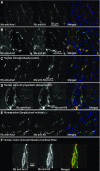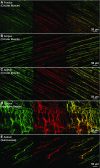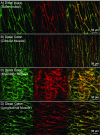Ano1 is a selective marker of interstitial cells of Cajal in the human and mouse gastrointestinal tract
- PMID: 19372102
- PMCID: PMC2697941
- DOI: 10.1152/ajpgi.00074.2009
Ano1 is a selective marker of interstitial cells of Cajal in the human and mouse gastrointestinal tract
Abstract
Populations of interstitial cells of Cajal (ICC) are altered in several gastrointestinal neuromuscular disorders. ICC are identified typically by ultrastructure and expression of Kit (CD117), a protein that is also expressed on mast cells. No other molecular marker currently exists to independently identify ICC. The expression of ANO1 (DOG1, TMEM16A), a Ca(2+)-activated Cl(-) channel, in gastrointestinal stromal tumors suggests it may be useful as an ICC marker. The aims of this study were therefore to determine the distribution of Ano1 immunoreactivity compared with Kit and to establish whether Ano1 is a reliable marker for human and mouse ICC. Expression of Ano1 in human and mouse stomach, small intestine, and colon was investigated by immunofluorescence labeling using antibodies to Ano1 alone and in combination with antibodies to Kit. Colocalization of immunoreactivity was demonstrated by epifluorescence and confocal microscopy. In the muscularis propria, Ano1 immunoreactivity was restricted to cells with the morphology and distribution of ICC. All Ano1-positive cells in the muscularis propria were also Kit positive. Kit-expressing mast cells were not Ano1 positive. Some non-ICC in the mucosa and submucosa of human tissues were Ano1 positive but Kit negative. A few (3.2%) Ano1-positive cells in the human gastric muscularis propria were labeled weakly for Kit. Ano1 labels all classes of ICC and represents a highly specific marker for studying the distribution of ICC in mouse and human tissues with an advantage over Kit since it does not label mast cells.
Figures








References
-
- Altschul SF, Gish W, Miller W, Myers EW, Lipman DJ. Basic local alignment search tool. J Mol Biol 215: 403–410, 1990. - PubMed
-
- Barajas-Lopez C, Berezin I, Daniel EE, Huizinga JD. Pacemaker activity recorded in interstitial cells of Cajal of the gastrointestinal tract. Am J Physiol Cell Physiol 257: C830–C835, 1989. - PubMed
-
- Berezin I, Huizinga JD, Daniel EE. Interstitial cells of Cajal in the canine colon: a special communication network at the inner border of the circular muscle. J Comp Neurol 273: 42–51, 1988. - PubMed
-
- Caputo A, Caci E, Ferrera L, Pedemonte N, Barsanti C, Sondo E, Pfeffer U, Ravazzolo R, Zegarra-Moran O, Galietta LJ. TMEM16A, a membrane protein associated with calcium-dependent chloride channel activity. Science 322: 590–594, 2008. - PubMed
Publication types
MeSH terms
Substances
Grants and funding
LinkOut - more resources
Full Text Sources
Other Literature Sources
Miscellaneous

